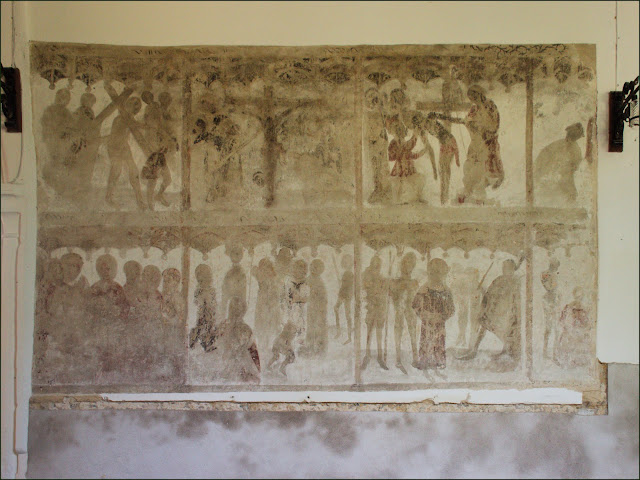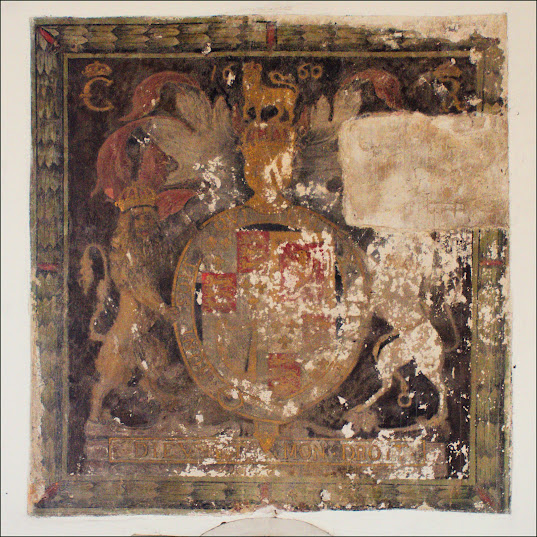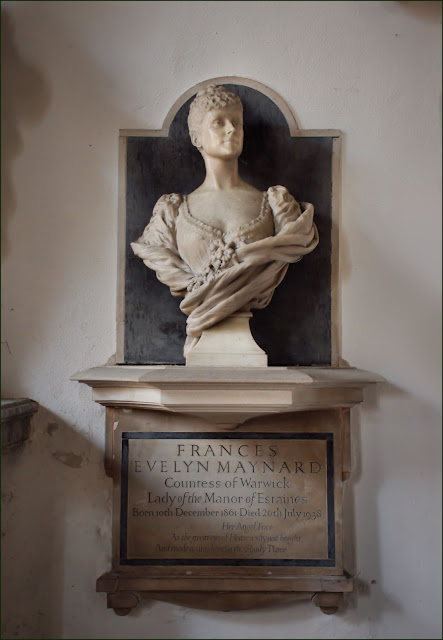Some time ago, back in the mists of memory, my brother took my parents for a Sunday afternoon drive. Unusually for that time I went along too. We passed through the pretty town of Saffron Walden, then, somewhere south of Thaxted, we started seeing signs for "The Lost Gardens of Easton Lodge". We followed them and arrived just as the garden was closing. We said we'd come back another day. We never did.
A Little About Easton Lodge:
The land here was granted by Queen Elizabeth I to Henry Maynard in 1590. A few years later he built a mansion on the site of an old hunting lodge. Maynard's descendants were still living in the house when it burnt down in 1847.
Like many homes of the aristocracy there was a walled garden which grew fruit and vegetables to help feed the large household and their many guests. They also grew flowers with which to decorate the many rooms.
What we see in the walled garden today, beautiful though it is, is very different from when it was in full production. Glasshouses would have occupied the whole length of the sunniest wall, fruit trees were trained along the other walls and both veg and flowers would be grown in rows for ease of picking. Even so it's been shown that these gardens were highly inefficient and were really just a means of showing off ones wealth.
Nowadays you'll find patches of mixed wildflowers to attract pollinators....
...and wide expanses of lawn - easier on the eye and easier to maintain than endless rows of vegetables and ranks of fruit trees. That water-tower in the distance stands on a neighbouring property, incidentally.
But the walls and doors remain and still provide shelter for the growing plants. Because this site is largely maintained by local volunteers it has a rather battered and homely feel, somewhat different from the smarter style of the National Trust or English Heritage. I like it.
When the old house was destroyed by fire the Maynards rebuilt in the fashionable Victorian Gothic style. Thomas Hopper was the architect. Then in 1865 there were deaths in the family which meant that three-year-old Frances Evelyn Maynard, always known as "Daisy", inherited the whole estate.
Daisy lived much of her life and later died in the same village. Those bald facts might suggest a quiet and limited life, typical of many women of that time. Nothing could be further from the truth.
So now we'll close the door on the walled garden and the history of the old house and we'll meet Daisy.
A Little About Daisy:
As you can see, she grew into a beautiful young woman. She carried on developing the gardens and in 1902 she commissioned Harold Peto to design an "Italian Garden" for her. I'll show you some pictures of it and fill you in on some of the gossip about "darling Daisy".
The Prime Minister, Benjamin Disraeli, took it into his head that she should marry Prince Leopold, Queen Victoria's youngest son. The Queen was in favour of the match, but the independent Daisy was having none of it. Instead, when she was 20, she married his equerry, Lord Brooke.
Lord Brooke succeeded to his father's earldom and Daisy became the Countess of Warwick. She had five children, only one of whom was thought to have been fathered by her husband. For nine years she was also the mistress of the Prince of Wales, who later became Edward VII.
Easton Lodge became one of the venues for the wild parties of "The Marlborough House Set", a group of wealthy aristocrats who gathered around the Prince of Wales. The whole group was famous for its disregard of Victorian values - extra-marital affairs, heavy gambling, lavish spending and rumours of financial misdealings.
After one particularly costly fancy-dress party the Countess received harsh criticism in a socialist newspaper. She went to see the editor, but rather than convince him to cease such coverage of her private affairs, she found herself being persuaded that such wastefulness was wrong.
Gradually her gatherings began to include more intellectuals and people with socialist leanings, such as Sidney and Beatrice Webb, George Bernard Shaw, H G Wells and the "Red Vicar of Thaxted", the Rev Conrad Noel.
In 1923 the Countess of Warwick completed her journey from socialite to socialist by standing as the Independent Labour Party candidate for Warwick and Leamington in the General Election. She failed to win but she made more and more donations to socialist causes. She was particularly active in providing education for agricultural workers.
After a while she found herself getting deeper and deeper into debt. She attempted to publish the letters that she had exchanged with the now King when she was his mistress. This would have caused a huge scandal, but lawyers argued (none too convincingly) that the copyright remained with the King and publication was blocked.
She eventually only escaped imprisonment by agreeing that when she published her autobiography she would use the money to settle her accounts. Unsurprisingly the book shocked upper-class society and was widely condemned (and widely read!). Ironically however, as time has passed, scholars have come to regard her memoirs as the most reliable and well-written record we have of those times.
A Little More About The Gardens:
In about 1920 the building above, known as the Shelley Pavilion, was imported from a house in Sussex and re-erected here, where it offered views down towards the lake.
The gardens had already become neglected by the time of Daisy's death in 1938. Then in 1939 the War Office took over the whole estate. The trees in the deer park were cleared in order to create an airfield for the 386th Bomber Group, "The Crusaders", of the USAAF. When they left after D-Day the RAF moved in and were billeted throughout the estate.
A memorial walk now exists to remember those who didn't return from their missions over enemy territory.
A Little About The Restoration Of The Gardens:
After the war the estate was returned to the ownership of Greville Maynard, Daisy's son, but the house was too large for his needs and most of it was pulled down. The gardens became overgrown and neglected.
Over the last few decades the gardens have been restored to something approaching their original splendour, though much remains to be done. Work appears to be taking place at present on the Japanese Garden which was once much more extensive.
If you visit on a Thursday (between 11 am and 3 pm) you will see today's volunteers hard at work in the garden. They will usually stop for a chat and answer any questions. The gardens are also open on Sundays during summer. (Check the website).
Just when you think you're making your way back to the car park you come across this dear little chap, inspired by "Kim" a baby elephant which was looked after by the Countess and used to wander freely in the grounds.
Not only that, but also a magnificent treehouse, a reconstruction of Harold Peto's original design. I'm glad we did make the effort to return to Easton Lodge Gardens. Eventually.
Take care.




























































